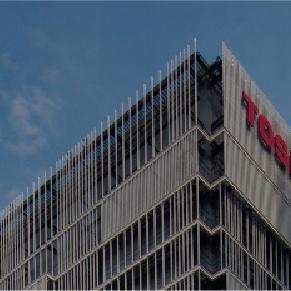Cancer Treatment Using Rotating Gantry of the Toshiba Heavy Ion Therapy System Starts at Yonsei University Health System
- NEWS RELEASE
- Nuclear Power
- Heavy Ion Therapy
- Order received / delivery
May 28, 2024
Toshiba Energy Systems & Solutions Corporation
KAWASAKI, JAPAN―Toshiba Energy Systems & Solutions Corporation (Toshiba) today announced that patients are now being treated in the first of two treatment rooms, each with a rotating gantry*1, that are part of the heavy ion therapy*2 system that it has installed at the Yonsei University Health System (YUHS) in Seoul, one of South Korea leading providers of medical services.
The system, the first in the world with two treatment rooms equipped with gantries that rotate around patients through 360 degrees to secure pinpoint beam accuracy, and one horizontal fixed treatment room, was supplied to YUHS in collaboration with DK Medical Solutions, one of South Korea’s most prominent medical companies. Treatment of cancerous tumors with the fixed beam started in April 2023, and now one of the treatment rooms with a rotating gantry has started to provide treatment, the first rotating gantry system that Toshiba has supplied overseas.
Like that already in operation at the East Japan Heavy Ion Center at the Faculty of Medicine, Yamagata University, the system at YUHS incorporates state-of-the-art technology developed by Toshiba to reduce energy consumption, the overall size and footprint of the system, to ensure easy operation and management, and generate less waste*3. It can deliver three-dimensional, high-speed scanning irradiation and respiratory-gated irradiation that contributes to patient comfort. Installation of the system began in 2021, and final adjustment processes were recently completed. The second treatment room with a rotating gantry is scheduled to enter operation by the end of this year.
Toshiba will continue to contribute to the global expansion of heavy ion therapy and the realization of high quality cancer treatment by proactively seeking orders in Japan and overseas.
*1: The angle of irradiation can be freely set through 360 degrees, allowing tumors to be irradiated from the optimum angle while the patient maintains a comfortable position. Combining the low scattering characteristics of heavy ion beams with scanning irradiation technology makes it possible to avoid healthy tissues and protect organs, further enhancing the concentration of the dose delivered to the cancer tumors.
*2: Radiation therapy that accelerates carbon ions to about 70% of the speed of light and produces a carbon ion beam (heavy particle beam) that is used to irradiate cancer tumors. A heavy ion beam spreads less than other particle beams and delivers a larger amount of energy to cancerous tumors with pinpoint accuracy, greatly reducing the likelihood of damage to normal surrounding cells. It is also more effective at destroying cancer cell genes than other types of radiation, and is recognized as a treatment that enables early recovery while imposing fewer physical burdens on patients.
*3: The compensation filter and patient collimator required by other particle beams are not necessary, which shortens the treatment period and reduces radioactive waste.
Information in the News Release, including product prices and specifications, content of services and contact information, is current on the date of the News Release , but is subject to change without prior notice.



